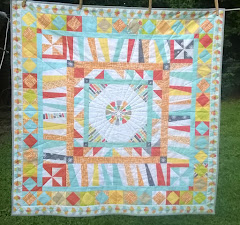
Ce finis! I am done...
This is my first completely finished large HAND quilted project . The top is one I purchased at Quilt Festival in Houston quite a few years ago. I bought it because a. it was really lovely and bed sized, and b. because I wanted to learn hand quilting and thought that if I bought an "old top" I wouldn't be heartbroken if it didn't turn out well...
At the time, I had the urge to make a quilt for my mom's 50Th wedding anniversary - that was at that time, still several years away. I wisely (I use that term loosely) thought that I could learn hand quilting faster if I had something BIG to practice on.
There was a LOT to learn. One of the first things I learned was how difficult it is to quilt something that has been poorly pieced. From a distance, the quilt looks so very flat - doesn't it! But there wasn't a "straight" seam on the top! Hand pieced, it was all there, undamaged, and made of a very nice quilt able Nile green cotton - probably a 1930's - 1950's fabric. But the quilter either was a beginner at piecing, or perhaps visually challenged. The curved piecing was so poorly done that many of the circular "hearts" were what is commonly known as "b" cups... they were not put together properly and didn't lay flat... each one had a bit of a "cup" to it.
I would just "quilt it out" as I had read about that in some older quilting books. Seam allowances also did not lay flat or in similar positions from block to block. Since many were stitched down the wrong way, they could not be pressed to a good position either.
And, the worst decision on my part was to "stitch in the ditch" - much easier in my mind, since no marking would be required. THIS meant that I would be stitching (at least half the time or more) THROUGH the 6 layers of top//seam allowances/batting/and backing.
The process was also going to serve as my first use of my husband's family quilt frame - which his mother left me when she died several years earlier - as there were no quilters in her family.
So, Unfortunately I didn't keep a record of when I purchased this top, and started quilting on it probably in about 1999 or so... It stayed in the frame almost 7 or 8 months, and then I pulled it, with about 3/4 done, and worked on it intermittently over the years... learning very quickly how mistaken I was at many of my original assumptions. A look at the quilt quickly shows my improvement over time from rough and crooked stitches to fairly consistent ones - though the difficulty of stitching through so many layers will never make this an award winner.
But, it is done, and IS now a lovely old quilt in the "Hearts and Gizzards" pattern, one of my favorites. Also known as "Dutch Windmill"... probably because that is a much more polite term! And Nile Green, so popular in the 30's, is just such a calming color. I fell in love with this top the moment I saw it. It will go out on my bed for use in the spring, and will give me something really spectacular to show off at our guild's next show and tell.
Here's a closeup of the work, that shows a relatively flat area, check out the wrinkles round the top right "heart" and look at how inconsistent the curved pieces are!!



